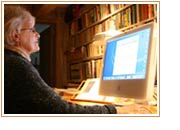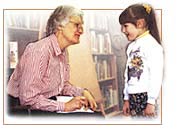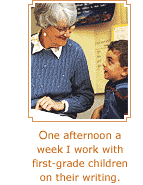 |









|
 |

|
 |
 |
 What inspired you to become a writer? What inspired you to become a writer?
 Where do you get your ideas? Where do you get your ideas?
 How long does it take you to write a book? How long does it take you to write a book?
 When and where do you do your writing? When and where do you do your writing?
 Why do you write so many different kinds of books? Why do you write so many different kinds of books?
 Are your characters based on your real life and people you know? Are your characters based on your real life and people you know?
 Do you know the whole story before you begin to write? Do you know the whole story before you begin to write?
 Do you make an outline? Do you make an outline?
 What is the best part about being a writer? What is the best part about being a writer?
 What is the worst part? What is the worst part?
 What advice do you have for young writers? What advice do you have for young writers?

|
 |
What inspired you to become a writer?
I became a writer because I loved books so much. However, when I was young, I didn't think it was possible to become a writer. It seemed too glamorous to be a real job. So I studied journalism, and planned to be a magazine editor. It was only when I stumbled accidentally into the field of children's book publishing that I finally thought, "Maybe I could do that."
|
 |
Where do you get your ideas?
 I find ideas in lots of different places. When I was a child riding in a car at night, I used to look into other people's houses, trying to spy into their lives. In a sense, I still do this. Wherever I go, I watch and listen. I can get an idea for a story from noticing a tiny chair sitting under a tree or overhearing a scrap of conversation. Driving car pools was a great source of ideas for me when my children were young. My son and daughter are responsible for some of my best ideas, and so are memories of my own childhood. I love old things. I collect antiques and like to find out how people lived a long time ago. My reading of adult books about American history has inspired a number of my books for children. I find ideas in lots of different places. When I was a child riding in a car at night, I used to look into other people's houses, trying to spy into their lives. In a sense, I still do this. Wherever I go, I watch and listen. I can get an idea for a story from noticing a tiny chair sitting under a tree or overhearing a scrap of conversation. Driving car pools was a great source of ideas for me when my children were young. My son and daughter are responsible for some of my best ideas, and so are memories of my own childhood. I love old things. I collect antiques and like to find out how people lived a long time ago. My reading of adult books about American history has inspired a number of my books for children.
How long does it take you to write a book?
It depends on what kind of book it is. For a picture book or Easy-to-Read book, it might take me a month or two. For a novel, it can take from six months to a year. And for historical fiction, I need to add on two or three months to do the research. I can't write about something until I feel comfortable that I know all about it. I should also add that after I write the first draft of a story, I am never satisfied. I will rewrite it two or three times, or sometimes more, before submitting it to my editor. Then, almost always, I rewrite at least parts of it again.
|
 |
|
When and where do you do your writing?
 I write in the mornings, from after-breakfast to lunch time. And if things are going well, I may write after lunch as well. When my brain gets tired, I stop for the day. I work at a computer in my office, which used to be my children's playroom. If I get stuck on something in my writing, I often go for a walk. Usually I find that by the time I get back, I have found an answer. I write in the mornings, from after-breakfast to lunch time. And if things are going well, I may write after lunch as well. When my brain gets tired, I stop for the day. I work at a computer in my office, which used to be my children's playroom. If I get stuck on something in my writing, I often go for a walk. Usually I find that by the time I get back, I have found an answer.
Why do you write so many different kinds of books?
That is a hard question to answer. Maybe it is because I have so many different kinds of ideas. Some of them seem appropriate for younger children, and some for older ones. I also like variety. After finishing a serious book, I enjoy writing something humorous. After writing a historical book, I find I am tired of doing research, and want to write about something I already know. But then, when I complete that book, I can't wait to do more research. Writing all kinds of books keeps me challenged.
|
 |
Are your characters based on your real life and people you know?
 Every character I create has bits and pieces of people I know. But I try never to create a character who is exactly like a family member or friend. In one of my early books, I had a character very much like my mother. After reading the story, she said to me, "That mother served store-bought salad dressing. And you know I always make my own!" I learned from that experience to do a better job of disguising my characters. I don't want to hurt anyone's feelings. The best thing that can happen is for a character to take on a life of his or her own. The person starts doing and saying surprising things, just like a real live person would. Then I know I really have a story. Every character I create has bits and pieces of people I know. But I try never to create a character who is exactly like a family member or friend. In one of my early books, I had a character very much like my mother. After reading the story, she said to me, "That mother served store-bought salad dressing. And you know I always make my own!" I learned from that experience to do a better job of disguising my characters. I don't want to hurt anyone's feelings. The best thing that can happen is for a character to take on a life of his or her own. The person starts doing and saying surprising things, just like a real live person would. Then I know I really have a story.
Do you know the whole story before you begin to write?
Do you make an outline?
I need to know the basic story before I begin writing. The first thing I do when I get an idea is start to make notes. I might jot down a title, a character, or even the first line of the story. Over days or weeks, the story will grow in my mind, and I make more detailed notes. At a certain point, it takes on a shape, with a beginning, a middle, and an end. Then I know this is going to be a book. Sometimes, if it is a story with a lot of plot, I will make a rough outline. Other times, I just know what certain chapters will be about, and I wait to see what is going to develop with my characters. I almost always know the ending, though.
What is the best part about being a writer?
 The best part about being a writer is the excitement of creating something new, taking a blank sheet of paper and inventing characters and a story that has never been told before. I get a thrill out of writing a good paragraph, or even a good sentence (some days that is all that happens from a whole morning at the my desk.) The other best part is finding out that children have read and liked what I have written. The best part about being a writer is the excitement of creating something new, taking a blank sheet of paper and inventing characters and a story that has never been told before. I get a thrill out of writing a good paragraph, or even a good sentence (some days that is all that happens from a whole morning at the my desk.) The other best part is finding out that children have read and liked what I have written.
|
 |
What is the worst part?
 The worst part is that writing is a lonely business. You have to sit all alone in a room for hours and hours. That is why I like to get out of the house some days and visit with children at schools. The worst part is that writing is a lonely business. You have to sit all alone in a room for hours and hours. That is why I like to get out of the house some days and visit with children at schools.
What advice do you have for young writers?
My best advice is, first of all, to read a lot of books. Even though you don't know it, you will be noticing how other people write and you will try to write as well as they do. The next thing to do is write a lot. Write for yourself and your family and your teacher. Write letters. Write for a school newspaper. Or start your own newspaper. Send your stories away to places where children's writing is accepted. Enter a contest. And finally, don't give up. Writing is like playing the piano or dancing or playing baseball. With practice, you'll see yourself getting better and better.
|



|
Here is a link to my friend Jennifer Thermes blog, where she answers questions like these: http://art-words-life.blogspot.com
Jennifer Thermes is a children’s book author, illustrator, and map illustrator.
Jennifer’s second book as author/illustrator, Sam Bennett’s New Shoes, was a Bank Street College Best Children’s Book. Her books as illustrator have received a Kirkus starred review, been included in a Bank Street College Best Children’s Book list, and been recognized in 3x3 Magazine’s Children’s Illustration Annual. A Horn Book Magazine review for the middle-grade novel Maggie & Oliver described her black & white art as "warm pencil drawings reminiscent of Lois Lenski. "Jennifer also specializes in illustrated maps, and has created frontispiece maps for books such as The Vine Basket, The Water Seeker, and Revolution Is Not a Dinner Party.
When not making art, Jennifer loves to read and work in her garden. She lives with her family, two cats, one dog, and an assortment of uninvited mice in an 18th century farmhouse in Connecticut.
|

Home | Meet JVL | JVL Bookshelf | Q&A | What's New |
Writing About History | Pig Tales | Links
|
|
 |



 I find ideas in lots of different places. When I was a child riding in a car at night, I used to look into other people's houses, trying to spy into their lives. In a sense, I still do this. Wherever I go, I watch and listen. I can get an idea for a story from noticing a tiny chair sitting under a tree or overhearing a scrap of conversation. Driving car pools was a great source of ideas for me when my children were young. My son and daughter are responsible for some of my best ideas, and so are memories of my own childhood. I love old things. I collect antiques and like to find out how people lived a long time ago. My reading of adult books about American history has inspired a number of my books for children.
I find ideas in lots of different places. When I was a child riding in a car at night, I used to look into other people's houses, trying to spy into their lives. In a sense, I still do this. Wherever I go, I watch and listen. I can get an idea for a story from noticing a tiny chair sitting under a tree or overhearing a scrap of conversation. Driving car pools was a great source of ideas for me when my children were young. My son and daughter are responsible for some of my best ideas, and so are memories of my own childhood. I love old things. I collect antiques and like to find out how people lived a long time ago. My reading of adult books about American history has inspired a number of my books for children. I write in the mornings, from after-breakfast to lunch time. And if things are going well, I may write after lunch as well. When my brain gets tired, I stop for the day. I work at a computer in my office, which used to be my children's playroom. If I get stuck on something in my writing, I often go for a walk. Usually I find that by the time I get back, I have found an answer.
I write in the mornings, from after-breakfast to lunch time. And if things are going well, I may write after lunch as well. When my brain gets tired, I stop for the day. I work at a computer in my office, which used to be my children's playroom. If I get stuck on something in my writing, I often go for a walk. Usually I find that by the time I get back, I have found an answer. Every character I create has bits and pieces of people I know. But I try never to create a character who is exactly like a family member or friend. In one of my early books, I had a character very much like my mother. After reading the story, she said to me, "That mother served store-bought salad dressing. And you know I always make my own!" I learned from that experience to do a better job of disguising my characters. I don't want to hurt anyone's feelings. The best thing that can happen is for a character to take on a life of his or her own. The person starts doing and saying surprising things, just like a real live person would. Then I know I really have a story.
Every character I create has bits and pieces of people I know. But I try never to create a character who is exactly like a family member or friend. In one of my early books, I had a character very much like my mother. After reading the story, she said to me, "That mother served store-bought salad dressing. And you know I always make my own!" I learned from that experience to do a better job of disguising my characters. I don't want to hurt anyone's feelings. The best thing that can happen is for a character to take on a life of his or her own. The person starts doing and saying surprising things, just like a real live person would. Then I know I really have a story. The best part about being a writer is the excitement of creating something new, taking a blank sheet of paper and inventing characters and a story that has never been told before. I get a thrill out of writing a good paragraph, or even a good sentence (some days that is all that happens from a whole morning at the my desk.) The other best part is finding out that children have read and liked what I have written.
The best part about being a writer is the excitement of creating something new, taking a blank sheet of paper and inventing characters and a story that has never been told before. I get a thrill out of writing a good paragraph, or even a good sentence (some days that is all that happens from a whole morning at the my desk.) The other best part is finding out that children have read and liked what I have written. The worst part is that writing is a lonely business. You have to sit all alone in a room for hours and hours. That is why I like to get out of the house some days and visit with children at schools.
The worst part is that writing is a lonely business. You have to sit all alone in a room for hours and hours. That is why I like to get out of the house some days and visit with children at schools.